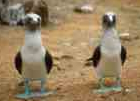 The
Galapagos Archipelago is a unique world heritage. Situated on the
equator some 600 miles off the coast of South America, this remote
volcanic archipelago remains much as it was millions of years ago. Over
the course of centuries, animal and plant life from the Americas reached
the islands and gradually evolved into new forms. Many of its species
are found nowhere else on earth.
Each of the archipelago's islands has its own character and unique
qualities. For example, Santa Cruz Island supports one of the largest
human populations of the five islands. Some 4,000 residents are
distributed among the cattle communities in the lush highlands and the
coastal town of Puerto Ayora. The
Galapagos Archipelago is a unique world heritage. Situated on the
equator some 600 miles off the coast of South America, this remote
volcanic archipelago remains much as it was millions of years ago. Over
the course of centuries, animal and plant life from the Americas reached
the islands and gradually evolved into new forms. Many of its species
are found nowhere else on earth.
Each of the archipelago's islands has its own character and unique
qualities. For example, Santa Cruz Island supports one of the largest
human populations of the five islands. Some 4,000 residents are
distributed among the cattle communities in the lush highlands and the
coastal town of Puerto Ayora.
|
Here you can visit the Charles Darwin Research
Station to see the land tortoises, or Galapagos, which once greeting
Darwin so peacefully.
Espanola (Hood) Island is one of the oldest of the islands. It small and
flat, with no volcanic crater or vent. Gardner Bay on the eastern shore
offers the islands most magnificent beach. It is used by a transient
colony of sea lions, and is a major nesting site for marine turtles. |
Geography: The islands lie in the Pacific Ocean about 1,000 km
from the South American coast and straddling the Equator. There are 13
large islands, 6 smaller ones and 107 islets and rocks, with a total
land area of about 8,000 square kilometres. The islands are volcanic in
origin and several volcanoes in the west of the archipelago are still
very active. Galapagos is a province of the Republic of Ecuador and five
of the islands are inhabited, with a total population of around 18,000
people. The capital is Puerto Baquerizo Moreno on San Cristobal Island,
although the largest town is Puerto Ayora on Santa Cruz.
Animal life
 Galapagos
is home to many unique, endemic animals, most of which are fearless due
to the lack of natural predators. One of the best known, the giant
tortoise, has evolved into fourteen distinct forms on the different
islands of the archipelago. Other reptiles include the marine iguana
which grazes on seaweed, land iguanas, lava lizards, geckos and snakes.
The only terrestrial mammals are rice rats and two species of bat. The
13 species of small, brownish finches are adapted to a range of
different foods and are known collectively as Darwin's finches. They
have been important to scientists trying to understand how evolution
occurs, and include the tool-using woodpecker finch. Other endemic (only
found in Galapagos) land birds include a hawk, dove, flycatcher, rail
and four species of mockingbird. Galapagos
is home to many unique, endemic animals, most of which are fearless due
to the lack of natural predators. One of the best known, the giant
tortoise, has evolved into fourteen distinct forms on the different
islands of the archipelago. Other reptiles include the marine iguana
which grazes on seaweed, land iguanas, lava lizards, geckos and snakes.
The only terrestrial mammals are rice rats and two species of bat. The
13 species of small, brownish finches are adapted to a range of
different foods and are known collectively as Darwin's finches. They
have been important to scientists trying to understand how evolution
occurs, and include the tool-using woodpecker finch. Other endemic (only
found in Galapagos) land birds include a hawk, dove, flycatcher, rail
and four species of mockingbird.
Plant life
 The
plants of Galapagos are equally fascinating. In the highlands are many
species of endemic Scalesia ('tree daisies') as well as tree ferns,
bromeliads and orchids. Around the coasts are giant prickly pear and
candelabra cacti while tiny Brachycereus cacti grow on barren lava
flows. On the shores can be found vivid morning glories and mats of
bright red sesuvium. Galapagos also has its very own, endemic species of
cotton, tomato, pepper, guava and passion flower. Many kinds of plants,
particularly those belonging to the daisy family, have evolved on the
different islands into whole arrays of endemic species, providing
scientists with classic examples of what is known as 'adaptive
radiation'. The
plants of Galapagos are equally fascinating. In the highlands are many
species of endemic Scalesia ('tree daisies') as well as tree ferns,
bromeliads and orchids. Around the coasts are giant prickly pear and
candelabra cacti while tiny Brachycereus cacti grow on barren lava
flows. On the shores can be found vivid morning glories and mats of
bright red sesuvium. Galapagos also has its very own, endemic species of
cotton, tomato, pepper, guava and passion flower. Many kinds of plants,
particularly those belonging to the daisy family, have evolved on the
different islands into whole arrays of endemic species, providing
scientists with classic examples of what is known as 'adaptive
radiation'. |